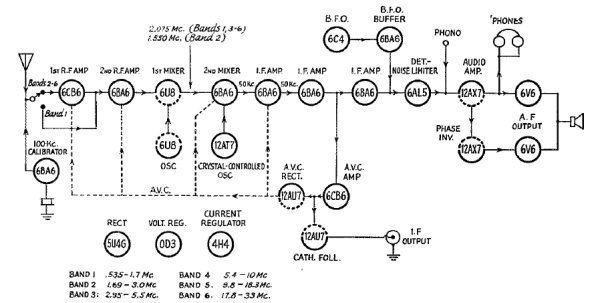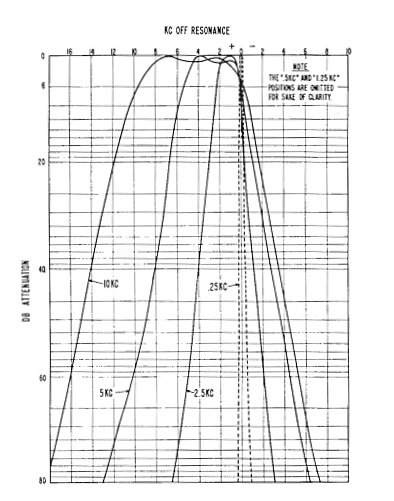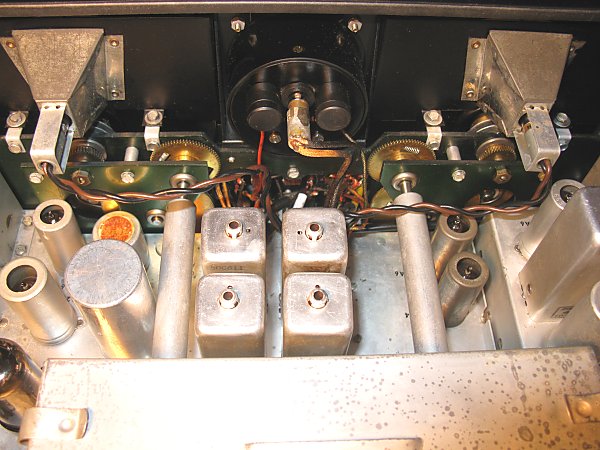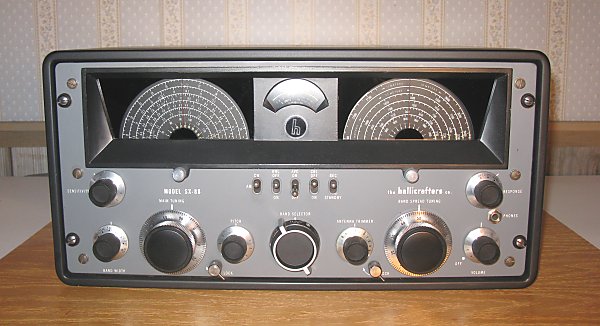|
|
|
|
10 Meter AM sensitivity: 0.3 uV for 10 dB S+N/N (1000 Hz tone , 30% modulation)
Notes:
Testing performed using 500 kHz IF filter position with the tone control set for a flat audio response 20 Hz - 20 kHz. As with other BA receivers tested, the SX-88 has excess gain requiring that the rf gain control be backed off from the fully advanced position. MDS improves about 3 dB when using the 250 Hz bandwidth position. A 10 Meter AM sensitivity measurement has been included ... as requested by Carl.
|
|
Receiver Particulars
A quick look at the SX-88 block diagram below doesn't show much 'magic' to support the 'mystique' surrounding the receiver. Consequently, it's not surprising that the dynamic range performance measures about on par with other receivers using the rf amplifier > rf amplifier > mixer > mixer scheme. Two rf amplifier stages increase sensitivity and improve image rejection but at the cost of reduced dynamic range. A high impedance probe / spectrum analyzer setup was used to 'sniff' IMD stage by stage in order to locate the 'weak link' in the chain. No surprise, the 1st mixer turned out to be the limiting factor. AM audio s/n performance, audio frequency response and audio distortion measurements are quite good.
|
|
|

|
|
|
The SX-88 ia a dual conversion receiver on all bands. Band 1, the broadcast band, uses a single rf amplifier stage. This provides a convenient means to study the difference in sensitivity and dynamic range - one vs. two rf amplifiers. Results on Band 1 are as follows:
|
|
|
|
|
|
|
Band
| MDS
| Blocking
| Two-tone D.R.
|
|
| | (20 kHz)
| (20 kHz)
|
|
| | | |
|
|
Band 1 (bdcst band)
| -128 dBm
| 112
| 90 dB
|
|
|
|
As expected, MDS suffers and blocking / two tone dynamic range improves. -128 dBm MDS is more than adequate on the broadcast band but would be considered 'deaf' on the higher bands - 20 meters and above.
The block diagram makes the SX-88 appear similar to other receivers of the period. There are, however, a number of differences and enhancements that make it an interesting receiver.
Two rf amplifier stages was standard fare at that time and makes for a very sensitive receiver with good image rejection. Hallicrafters rated image rejection at between 60 and 120 dB depending on the band - the higher bands having lower rejection. Since the SX-88 was aimed at the high end market mixer stages were used in place of converter stages (combined LO and mixer) which were becoming popular at the time.
Frequency stability was enhanced using ceramic coil forms for the 1st LO. The company touted that the LO circuits were individually compensated for each band. Crystals were used for the 2nd LO. Voltage and current regulator tubes further improved oscillator stability. Frequency drift was measured over a 30 minute period on a warmed up receiver and found to be as follows: 160M - 10 Hz, 80M - 10 Hz, 40M - 20 Hz, 20M - 25 Hz, 15M & 10M - 80 Hz. Hallicrafters did not spec frequency drift.
Selectivity is carried out at the 50 kHz second IF with 3 amplifier stages and 8 tuned circuits. There is no crystal filter. Selectivity is variable in six steps from 250 Hz to 10 kHz and accomplished by carefully varying the Q and coupling of the various tuned circuits. Hallicrafters made a big deal about the special 50 kHz IF cans used in the SX-88 to obtain the narrow 250 Hz bandwidth position. As the story goes, to achieve their goal of a Q of 180 they had to devise a method other than brass adjusting screws - which lowered the Q. The ferrite cores were instead threaded and rode in threads 'embossed' in the phenolic coil forms. A slot in the core was provided for adjustment. This new adjustment arrangement plus a somewhat unusual winding technique to maximize Q and the ferrite lined IF cans (similar to a pot core) allowed them to reach their goal. In the course of the restoration one of the IF cans was removed and measured 26 mH at a Q approaching 230 on an HP-4342A Q meter. The SX-88 appears to be the only receiver to have used these impressive coils.
As a consequence of the adjustable coupling/adjustable Q bandwidth technique, the passband center does not remain constant but rather 'grows' higher in frequency as the bandwidth is increased. The graph below shows this in detail. In operation this takes some getting used to.
|
|

|
|
|
The permeability tuned BFO / buffer amplifier is a bit unusual in that it has three positions - CW, OFF and SSB. In the SSB position the BFO injection is increased to a level about 8 times that used for cw reception. The higher level of BFO injection makes for noticeably lower distortion on SSB reception. While not as good as a product detector this high level injection is a definate improvement. Flipping the BFO switch between CW and SSB readily demonstrates this.
AVC is also an important factor for good SSB reception. An independant AVC amplifier and detector allow AVC to be used on CW/SSB reception as well as AM. AVC is unaffected by the BFO injection unlike receivers where the envelope detector is also the AVC detector. The receiver retains full sensitivity with the BFO in either cw or ssb position.
Push-pull 6V6s with inverse feedback and 10 watts output have no problem producing room filling audio. Taps are provided for 3.2, 8 and 500 ohms. The tone control has 5 positions: Bass Boost, High Fid, Normal, Comm1 and Comm 2. A graph of the frequency response can be found in the sales brochure referenced above. The restricted Comm1 and Comm2 settings are useful for reducing 'boominess' when receiving SSB using narrow bandwidths. Bass Boost adds about 10 dB to the low end and is a pleasant addition when listening to high fidelity shortwave broadcasts and 'full fidelity' amateur stations.
Other features include a built-in 100 kHz crystal calibrator, buffered 50 kHz i-f output for a scope, noise limiter, phono input, and a monitor control that permits adjustment of the receiver sensitivity when monitoring your own transmitter signal.
Some mention of the main tuning and bandspread gear train assembly is in order. With it's .125" think plates, multiple anti-backlash gears, ball type bearing surfaces, tension adjustments, end stops, zero frequency shift dial locks and flywheel weighting it is indeed impressive. An overhauled and properly lubricated and adjusted gear train makes for silky smooth tuning controls with zero backlash. The picture below shows some detail of the gear train after reassembly. Each side is a mirror image of the other ... once you've finally mastered reassembly of the first side (several attempts may be necessary) the other side is a piece of cake!
|
|

|
|
|
The SX-88 is no lightweight tipping the scales at a hefty 79 lbs - certainly one of the heaviest receivers in my collection. Measuring 20" wide and 18-1/4" deep it takes up some real estate on the operating desk. Alternatively it can be removed from its case for rack mounting. Panel height is 8-3/4".
Using the SX-88
Aside from the lackluster dynamic range numbers there are a number of things to like about the SX-88. As a cw receiver, the 250 Hz position and no secondary response on the opposite side of zero beat are pretty impressive. Strong adjacent cw signals sitting at the edge of the bandpass don't cause filter 'rattle' as with most 'modern' mechanical or crystal filters. The variable BFO is rock solid and CW reception with the AVC works well.
As an AM receiver the 10 kHz bandwidth position is certainly welcome when broadcast material and conditions are right. The low distortion detector and push-pull 6V6s make for enjoyable listening when played through suitable (large) speakers. When the going gets tough there are the 5 kHz and 2.5 kHz bandwidth positions and the high level SSB BFO aids in exalted carrier AM reception.
SSB reception using the high level BFO injection with AVC turned on is actually pretty good. Listening in the 5 kHz bandwidth and using the BFO to move a signal around in the passband often results in more 'lifelike' sounding SSB signals when compared side by side with a modern receiver. This may be due to the less restrictive bandwidth and less distortion at the filter slopes due to the LC filtering.
< sidenote > This makes one wonder if 'we' didn't go the wrong direction when adopting the crystal / mechanical filter method of generating and receiving single sideband - at least where fidelity is concerned. Phasing type SSB transmitters have always seemed to sound better. < /sidenote >
Frequency calibration and resettability is aided by a built in 100 kHz calibrator, main tuning and bandspread dials with 24 division logging scales and tuning knob skirts marked 0 - 100.
One negative that needs mentioning is VFO pulling on moderately strong signals on the higher bands. While fairly minor it is annoying. Investigation did not turn up any obvious cause for the problem. A buffer stage between the VFO and 1st mixer would likely cure the problem.
And last is the subjective fit, finish, feel and look. Since the station receiver is usually front and center, and one spends a fair portion of their operating time manipulating the controls, these things matter. In all categories I would give the SX-88 high marks. The receiver is well constructed and reasonably 'heavy duty' and the paint scheme is pleasing to the eye. Front panel layout with the big half moon dials and well laid out controls enhance the operating experience. All controls have a solid feel - especially the 'long throw' bandswitch with large spring loaded cam / detent and of course the main tuning and bandspread tuning controls. Dial lights illuminate only the band in use. As others have pointed out, the dial lighting is best appreciated in a dimly lit room. Several receiver afficianados have opined that the SX-88 is one of, if not the best looking BA receiver ever!
The Competition
It's interesting to consider what other high end amateur receivers were competing in the market at the time. The following list was compiled from the www.radioing.com website.
|
|
|
|
|
|
Model
| Years
| Price
|
|
|
| | |
|
|
| | | |
|
|
National NC-183D
| 1952-1959
| $369 - $449
|
|
|
National HRO-60
| 1952-1964
| $485 - $745
|
|
|
Collins 75A3
| 1952-1954
| $530
|
|
|
Hallicrafters SX-88
| 1954-1955
| $595
|
|
|
Hammarlund SP-600
| 1951-1972
| $980 - $1150
|
|
|
|
|
All of the receivers other than the SX-88 currently sell for roughly what they did when originally manufactured. Had the SX-88 had been produced in large numbers it's likely the current price would be more in line with the others.
Serial number 343 Run 1
After a few years of searching for just the right SX-88 for this project, S/N 343 Run 1 became available for purchase. The prime requirements were that the receiver be in original unmolested and unrestored condition with no major defects and reasonably good cosmetics. This receiver filled the bill of being bone stock with the exception of a couple filter caps tack soldered to the original filter can. A sticky coating of tar and nicotine from a previous owner covered all surfaces and Jiffylube would have been impressed with the grease job on the gear train. These are not necessarily bad things as the coatings actually protect the underlying surfaces and when cleaned off revealed the chassis and painted surfaces to be in very good condition.
The SX-88 uses about 50 of the infamous 'bumble bee' tubular capacitors ... some easy to get to others significantly more difficult. Not a single one of the 50 capacitors passed the leakage test. A dozen or more carbon composition resistors were replaced as they had drifted beyond tolerance. The filter can was replaced as were a couple other small electrolytic capacitors. Luckily all of the silver mica caps retained their value and none have proved noisy ... so far.
The receiver retains its original paint with just a small touchup on the top front of the cabinet where a piece of equipment stacked above must have chipped the paint. There are a number of scratches and abrasions and a knob rub behind the skirt of the bandswitch. The chassis and IF cans have not been polished to an unnatural mirror finish.
Start to finish the restoration and performance verification consumed several hours most nights over the course of several months. Particularly time consuming was the overhaul of the gear train, removal of the 'catacombs' and the second mixer / second LO /1st IF amp sub assembly for capacitor / resistor replacement. A great deal of time was spent making measurements and testing components in place, such as the I-F transformers, silver mica caps, etc. to ensure that performance would be reasonably representative of a receiver just leaving the factory.
Jay Rusgrove W1VD
|
|
|
| |



